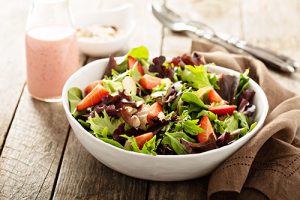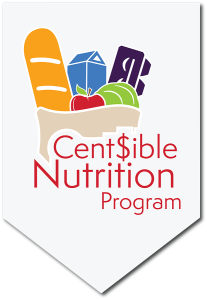Lettuce is a cool-season vegetable, which means it does well in spring and late summer when temperatures are cooler. Unlike some other plants, such as zucchini and squash, lettuce can handle a little frost and still live. This makes it a great vegetable to grow many parts of Wyoming, especially places at high elevation with a short growing season.
There are four types of lettuce: head, bibb, romaine or cos, and leaf. Head is the most common for grocery store sales. Bibb is often grown in structures like greenhouses. Romain or cos lettuce is a very nutritious and forms a tall, long head. Leaf lettuce is the most common for home gardens and has green or red-tinged leaves.
Planting
- Lettuce does best in shaded areas. Pick a cool area of the garden, or plant it on the shady side of tall crops like sweet corn, tomatoes, and pole beans.
- Start lettuce seeds or set seedlings in the ground two weeks before the last average frost date.
- Plant leaf lettuce in rows 8-12 inches apart with 10-20 seeds per foot. You can also sprinkle the lettuce seeds evenly over an area of soil and gently scratch it into the soil.
- Leaf lettuce grows quickly and can be planted between or in rows of slower growing crops like tomatoes, broccoli, and Brussels sprouts.
- Head lettuce is often started inside and transplanted outside. When transplanting, space seedlings 12-18 inches apart in rows 24-30 inches apart.
- It is best to avoid planting lettuce in the hottest part of summer. Leafy greens tend to struggle to grow in the heat, but can make a comeback in the fall.
Harvesting
- Leaf lettuce is ready to harvest when the plants are five to six inches tall. Harvest the largest plants first to give the other plants more room to grow.
- Bibb lettuce is ready to harvest when the leaves begin to cup inward and form a loose head.
- Romaine lettuce is ready to harvest when the leaves are long and overlap to form a tight head about 4 inches wide at the base and 6-8 inches tall.
- Head lettuce is ready to harvest when the leaves overlap to form a firm head similar to those found in a grocery store.
Suggested varieties:
Head types: Butter Crunch, Ithaca, Mini Green, Summertime
Leaf types: Black Seeded Simpson, Crispy Frills, Prizeleaf, Red Sails, Royal Oak, Simpson Elite
Happy gardening!
Information summarized from UW Extension publications by Katie Shockley, Writer/Editor, University of Wyoming Extension Communications & Technology.
Share
Want more on gardening? Check out UWE’s Lawn & Garden podcast.
Lettuce is a cool-season vegetable, which means it does well in spring and late summer when temperatures are cooler. Unlike some other plants, such as zucchini and squash, lettuce can handle a little frost and still live. This makes it a great vegetable to grow many parts of Wyoming, especially places at high elevation with a short growing season.
There are four types of lettuce: head, bibb, romaine or cos, and leaf. Head is the most common for grocery store sales. Bibb is often grown in structures like greenhouses. Romain or cos lettuce is a very nutritious and forms a tall, long head. Leaf lettuce is the most common for home gardens and has green or red-tinged leaves.
Planting
- Lettuce does best in shaded areas. Pick a cool area of the garden, or plant it on the shady side of tall crops like sweet corn, tomatoes, and pole beans.
- Start lettuce seeds or set seedling in the ground two weeks before the last average frost date.
- Plant leaf lettuce in rows 8-12 inches apart with 10-20 seeds per foot. You can also sprinkle the lettuce seeds evenly over an area of soil and gently scratch it into the soil.
- Leaf lettuce grows quickly and can be planted between or in rows of slower growing crops like tomatoes, broccoli, and Brussels sprouts.
- Head lettuce is often started inside and transplanted outside. When transplanting, space seedlings 12-18 inches apart in rows 24-30 inches apart.
- It is best to avoid planting lettuce in the hottest part of summer. Leafy greens tend to struggle to grow in the heat, but can make a comeback in the fall.
Harvesting
- Leaf lettuce is ready to harvest when the plants are five to six inches tall. Harvest the largest plants first to give the other plants more room to grow.
- Bibb lettuce is ready to harvest when the leaves begin to cup inward and form a loose head.
- Romaine lettuce is ready to harvest when the leaves are long and overlap to form a tight head about 4 inches wide at the base and 6-8 inches tall.
- Head lettuce is ready to harvest when the leaves overlap to form a firm head similar to those found in a grocery store.
Suggested varieties:
Head types: Butter Crunch, Ithaca, Mini Green, Summertime
Leaf types: Black Seeded Simpson, Crispy Frills, Prizeleaf, Red Sails, Royal Oak, Simpson Elite
Happy gardening!
Information summarized from UW Extension publications by Katie Shockley, Writer/Editor, University of Wyoming Extension Communications & Technology.
Summer Sunshine Garden Salad

Ingredients
• 5 cups mixed leafy greens (lettuce, spinach, and/or kale)
• ½ red onion, sliced thin
• ½ red pepper, sliced into strips
• 1 cucumber, sliced into rounds
• 1 cup fruit slices (grapes, strawberries, oranges, or mango)
• 1/3 cup lite vinaigrette dressing
Directions
- Wash hands with warm, soapy water.
- Wash ingredients before cutting. Store-bought greens may not need to be washed (check the bag). Green picked from the garden need to be thoroughly rinsed under cool, running water.
- Pat ingredients dry with clean paper towels.
- Slice ingredients.
- Toss everything together in a large bowl.
- Add dressing and toss again.
- Serve immediately.
Makes 5 servings.
Additional Resources
Learn more about growing and harvesting lettuce with these resources from the University of Wyoming Extension:
- Video: Growing Leafy Greens
- UW Extension bulletin: Vegetable Gardening, p. 12-13
- Barnyards & Backyards article: Some Veggies like it hot and some like it not
Next up: All Things Spinach [Coming August 7]


